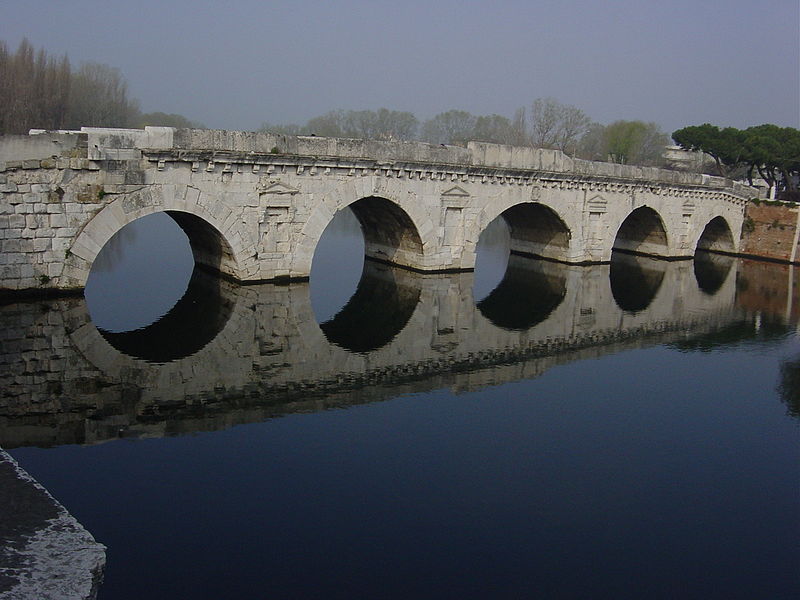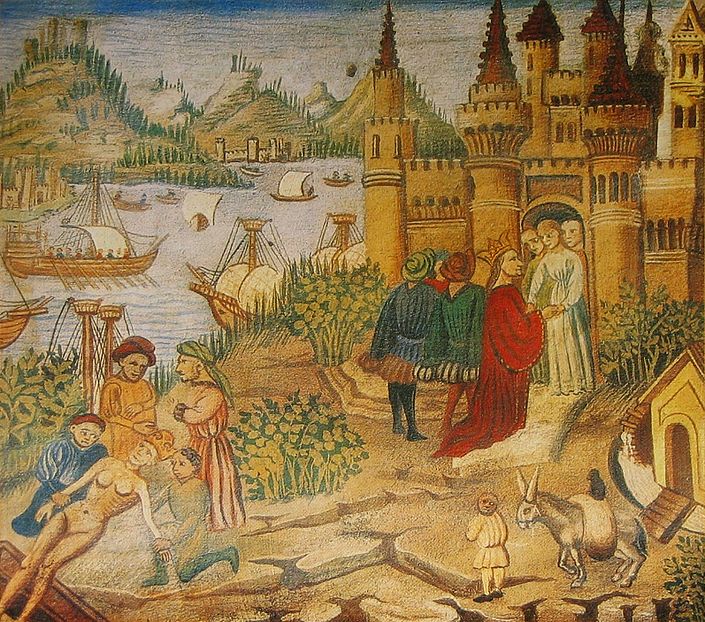 |
| Matilda of Canossa (R) |
The
Empire Fights Back
The aftermath of the battle at Volta saw Matilda busy trying to settle a dispute between the Bishop of Ferrara and the Abbot of Pomposa. Gregory meanwhile was trying to undermine Ravenna from within. From now on Matilda and her forces were reduced to reacting to Henry’s initiatives.
In 1081 the Emperor decided to travel once more to Italy to reinstate his over-lordship across all his territories in the peninsula. He left the majority of his army in Germany to defend the empire against the rebels, weakened by the death of Rudolf of Swabia but not completely down trodden. Combined with the troops left at Ravenna, Henry’s army in Italy was more than sufficient to fight his enemies.
By Easter 1081 Henry reached Verona and by the end of April was in Milan. He declared Matilda, on account of her 1079 donation to the Church, forfeit and banned her from the Empire; although this wasn't enough to eliminate her as a source of trouble, for she retained substantial allodial holdings.
Matilda’s allies started deserting her; Bishop Theodoric of Verdun threw his lot in with Henry before the fighting started in Italy. In March 1081 the situation was so dire that Gregory wrote to Bishop Altmann of Passau and Abbot William of Hirsau begging for assistance;
 |
| Conrad |
‘If indeed no assistance shall be forthcoming from
you for our daughter Matilda, the morale of whose knights you have weighed,
what else remains save that, when her men shall refuse to offer
resistance….either she should surrender under compulsion to his peace or else
she should lose whatever she seems to possess?’[i]
Matilda had already informed Gregory that Henry was trying to embroil Robert Guiscard in his affairs by marrying his son Conrad to Robert’s daughter Emma[ii]. Robert chose not to get involved in Henry’s machinations but by then the majority of the prelates of northern Italy were supporting Henry, leaving only the bishops of Mantua and Ferrara supporting Matilda. Lucca supported Henry, joined by Pisa in the summer.
In Retreat
 |
| Via Aemilia |
Henry’s supporters laid waste to Matilda’s lands, requisitioning what they pleased for themselves. Indeed they complained bitterly when Henry proposed travelling on down to Rome; the turmoil had on-effects on travellers in the north. The chronicler Bernold of Constance reported;
During these times Henry so disturbed the whole of
Italy that no one was able to travel safely to the doors of the apostles, who
did not first swear that he would not defect to Pope Gregory.’[iii]
Henry reached Rome on 21st May 1081 and from then on he and Matilda matched wits throughout northern Italy. Matilda was forced to use her funds to hire mercenaries, supply and protect her castles and fend off Henry’s attacks. Henry did not have the siege engines available to break down the gates to the eternal city that had been closed to him upon his arrival.
The resistance of the townspeople, nobles and citizens alike, forced Henry into retreat into Tuscany where Henry’s men encircled the domain of Canossa. In the absence of Bishop Anselm[iv] Henry had the Anti-bishop Peter consecrated with Anselm’s discarded regalia, by Bishop Wibert. While in Lucca Henry held a court that found Matilda guilty of treason; her vassals were no longer bound to support her. She was deprived of her lands in Italy and Lorraine; Matilda was now an outlaw in the eyes of the Imperial court.
Matilda did not have the strength to put an army in the field and overcome Henry’s troops, while Henry was unable to besiege Matilda’s castles. The standoff was to continue, but the cost of keeping Henry’s men at bay was draining and within four years Bishop Anselm was reduced to asking the Bishop of Pistoia for a loan of £100.
The Antipope
 |
| Alexis I Komnenos |
Gregory took refuge in the Castell Sant’Angelo. He was running short of funds and started using church monies in a way they had never been meant for. He was denounced by his clergy who argued that church funds should not be alienated for military purposes. Matilda had no such compunctions, in 1082 she liquidated the funds of the monastery at Canossa.
For the next two years Gregory and Matilda remained on the defensive; in Rome Gregory was fighting a losing battle as Henry won hearts and minds. By the summer of 1083 the majority of the citizens supported him. He also laid siege to Matilda’s castle of Carpi[v]. When Henry returned to Rome he found that the mercurial temperament of the Romans had caused a veering of public opinion in favour of Gregory, who had received monies from Robert Guiscard enabling him to continue in his defiance of the emperor.
In an attempt to contain Gregory within his place of refuge Henry commenced works, fortifying;
‘A certain hill called the Palatiolus right by St Peter’s, and stationed many knights in it, so that they
might fight the Romans, who were not letting him enter the areas on the other
side of the Tiber.’[vi]
 |
| Salerno |
Due to time pressures Robert Gusicard did not remove the antipope who took himself off to Tivoli[vii][viii]; Guiscard was concerned about the machinations of Alexis Komnenos and his troops, having made themselves unpopular by burning down parts of the city, and they departed from Rome in July. They took Gregory with them to Salerno[ix] where he died the following year. Clement was able to re-enter Rome by November 1084.
The Aftermath
The period
following Gregory’s death was a low point for those wishing to reform the
church, for most of the next four years they were unable to produce anyone as a
viable pope bar the weak and short-lived Victor III[x]. Matilda took the lead in reinvigorating
her allies with letters; writing to the German faithful in the aftermath of
Henry’s departure, advising them to ignore Henry’s orders;
‘If, therefore, he [Henry]
wants anything to be accomplished among you or against you through his authority,
do not doubt that he is a false witness. You must not believe anyone who dares
to speak differently than we.’[xi]
 |
| Abbey of Nonatola |
In July 1084
Matilda’s troops won the Battle of Sorbara, Henry was already in Germany by
this time. The forces he left behind were attempting to finish off what Henry
had begun, subduing Matilda’s lands and removing the last of her possessions.
Matilda launched her counter-attack on Henry’s allies, Eberhard and Gandulf , the
bishops of Parma and Reggio and Margrave Obert IV of Massa.
To fund her counter-attack Matilda seized the funds of Nonatola’s monastery. Her
presence at the battle is a matter of dispute, although she must have been
relatively near Sorbara to direct her few troops. Her cavalry charged the enemy
camp at dawn and swept through the enemy lines. Gandulf[xii] and Obert fled leaving
their troops demoralised and leaderless. Matilda’s men took 100 knights, ten
captains and Bishop Eberhard prisoner along with 500 horses, all the enemy’s
tents and many coats of mail.
Bibliography
The Making
of Europe – Robert Bartlett, Penguin Books 1994
The Military
Leadership of Matilda of Canossa – David J Hay, Manchester University Press
2008
The Holy
Roman Empire – Friedrich Heer, Phoenix Giant Paperback 1995
The Oxford
History of Medieval Europe – George Holmes, Oxford University Press, 2001
Absolute
Monarchs – John Julius Norwich, Random House 2011
The First
Crusade – Steven Runciman, Folio Society 2002
The Hapsburgs
– Andrew Wheatcroft, Folio Society 2004
www.wikipedia.en
[i]
The Military Leadership of Matilda of Canossa - Hay
[iii]
The Military Leadership of Matilda of Canossa - Hay
[iv]
Appointed after his uncle, the reigning bishop, was made Pope Alexander II;
Anselm fled to Moriana
aka St-Jeanne-de-Maurienne, in southern France
[vi]
The Military Leadership of Matilda of Canossa - Hay
[x]
He died in 1087, after reigning for a year
[xi]
The Military Leadership of Matilda of Canossa - Hay
[xii]
The attack was so sudden he did not have time to put on his armour and spent
the next three days in hiding, before managing to make his escape.
A most unrestful period!
ReplyDelete